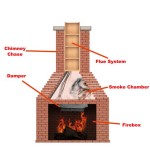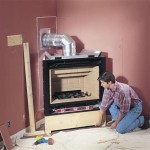How to Install Gas Logs in Your Fireplace
Gas logs offer a convenient and aesthetically pleasing alternative to traditional wood-burning fireplaces. They provide the ambiance of a real fire without the hassle of chopping wood, building a fire, and cleaning up ashes. Installing gas logs is a task that many homeowners can undertake themselves, provided they possess a basic understanding of gas lines and safety precautions. This article provides a comprehensive guide to installing gas logs in your fireplace.
Before commencing any installation, it is crucial to understand the different types of gas logs available. Vented gas logs are designed for use in fireplaces with a fully functioning chimney. They produce a realistic flame and greater heat output but require the chimney to be open during operation for proper ventilation. Vent-free gas logs, on the other hand, do not require a working chimney and are equipped with an oxygen depletion sensor (ODS) that shuts off the gas supply if oxygen levels in the room become too low. Vent-free logs typically produce less heat and may not have as realistic a flame appearance as vented logs. Choosing the correct type of gas logs for your fireplace and application is the initial and arguably most important step.
Safety is paramount when working with gas. Prior to starting the installation, ensure the main gas supply to the fireplace is completely shut off. Locate the gas shut-off valve, typically situated near the fireplace or close to the gas supply line. Use a gas line wrench to turn the valve to the "off" position. Double-check that the gas is off by briefly attempting to light the existing gas valve (if applicable) after turning off the main supply. If a propane supply is involved, extreme care is warranted, and a manometer is essential for pressure testing.
Preparing Your Fireplace for Gas Log Installation
The first step is to clean your fireplace thoroughly. Remove any existing grates, ashes, or debris. Inspect the firebox for any cracks or damage. Small cracks can be repaired with high-temperature mortar. If the firebox is severely damaged, consult with a professional before proceeding. A structurally sound firebox is essential for safe operation.
Next, ensure that the fireplace's damper is either fully open (for vented logs) or permanently blocked (for vent-free logs). For vented logs, the damper must remain open during operation to allow for proper ventilation and prevent the buildup of carbon monoxide. For vent-free logs, blocking the damper is mandatory to prevent heat loss and ensure optimal performance. Damper clamps can be used to permanently hold the damper open or closed, depending on the type of logs being installed.
The gas line connecting to the fireplace must be inspected for leaks and proper size. Use a gas leak detector solution to check for leaks along the gas line and fittings. Apply the solution to all connections and look for bubbles, which indicate a leak. If a leak is detected, tighten the connection or replace the fitting. The existing gas line must be correctly sized to provide adequate gas flow for the new logs. Consult the manufacturer's specifications for the gas logs to determine the required gas pressure and flow rate.
Installing the Gas Log Burner System
The gas log burner is the mechanism that distributes the gas to the logs and creates the flames. Carefully unbox the burner and follow the manufacturer's instructions for assembly and placement within the firebox. The burner should be positioned according to the manufacturer's specifications to ensure proper combustion and flame appearance.
Connect the gas line to the burner using a gas-rated flex connector. Ensure that the flex connector is the correct size and length for the application. Use pipe sealant or Teflon tape specifically designed for gas lines to create a gas-tight seal. Tighten the connections securely with a gas line wrench. After connecting the gas line, perform another gas leak test using the gas leak detector solution.
Many gas log sets include a control valve for adjusting the flame height. Install the control valve according to the manufacturer's instructions. The control valve is typically located on the burner or near the gas inlet. Ensure that the control valve is easily accessible for operation. Remote controls are available for some gas log sets, offering added convenience.
Arranging the Gas Logs
The placement of the gas logs is crucial for achieving a realistic fire appearance. Carefully arrange the logs on the burner according to the manufacturer's instructions. Avoid obstructing the burner ports or pilot light. The logs should be positioned in a manner that allows for proper air circulation and prevents the buildup of soot. Do not stack logs too close together, as this can restrict airflow and create a dense, unnatural flame.
Pay attention to the aesthetic aspect of the log arrangement. Most gas log sets are designed with specific log placements in mind to create a realistic fire appearance. Refer to the manufacturer's instructions or diagrams for guidance. Experiment with different arrangements to find the look that is most appealing. The goal is to create a visually convincing representation of a natural wood fire.
Once the logs are in place, double-check that all connections are secure and that there are no gas leaks. Turn on the main gas supply to the fireplace and attempt to light the burner. Follow the manufacturer's instructions for lighting the pilot light (if applicable) and adjusting the flame height. Observe the flame pattern to ensure that it is even and realistic. If the flame is uneven or there are any issues with the burner, consult the manufacturer's troubleshooting guide.
Post-Installation Checks and Safety Measures
Following installation, it is essential to perform thorough safety checks. Use a carbon monoxide detector to monitor the levels of carbon monoxide in the room, especially during the initial operation of the gas logs. Ensure that the detector is functioning properly and that the batteries are fresh. A carbon monoxide detector is a critical safety device for any home with a gas-burning appliance.
Regularly inspect the gas logs and burner for any signs of damage or wear. Clean the logs and burner periodically to remove any soot or debris. A clean burner will operate more efficiently and produce a cleaner flame. If any issues are detected, consult with a qualified technician for repairs. Regular maintenance will extend the life of the gas logs and ensure safe operation.
Keep flammable materials away from the fireplace opening. Maintain a safe distance between the fireplace and any curtains, furniture, or other flammable items. Never leave the fireplace unattended while it is in operation. Ensure that all users of the fireplace are aware of the safety precautions and operating instructions. Adhering to safety guidelines is crucial for preventing accidents and ensuring the safe enjoyment of your gas logs.

How To Select And Install A Gas Fireplace Log Set Fireplaces Direct Learning Center

How To Select And Install A Gas Fireplace Log Set Fireplaces Direct Learning Center

Installing Vent Free Gas Log Set

How To Put In A Gas Log Set For Fireplace Ron Hazelton

Vented Gas Logs Heater Or Decorative Bart Fireside

Can I Install Gas Logs In My Existing Fireplace Thomas Bros Propane
.png?strip=all)
How To Install A Log Lighter Fireplace Gas Starter Pipe

How To Install A Gas Log Fireplace Ask This Old House

What You Need To Know About Gas Fireplace Logs Fireplaces Direct Learning Center

Here S How Install A New Fireplace Surround And Gas Logs
Related Posts








